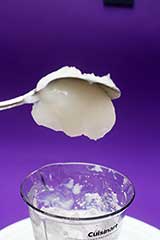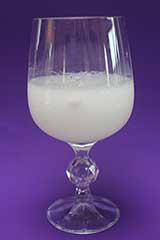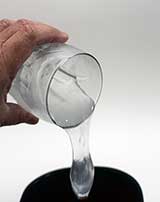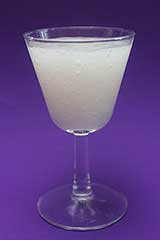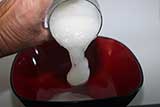Meats and Sausages
Gums
You need starches, flours, and gums to bind ingredients together; there is no way around it. Meat contains proteins released during cutting/grinding, and these proteins dissolve in salt and water. As a result, a sticky substance called exudate is created, which binds meat particles together. Meat cuts, which are rich in connective tissue, skin included, when slow cooked produce gelatin, which solidifies again upon cooling, binding ingredients together. Vegetarian sausages do not include meat or gelatin, so we need more elaborate solutions to bind ingredients together; we need gums. Gums, technically referred to as hydrocolloids, originate from different sources. They can immobilize water and contribute to viscosity. We are familiar with two hydrocolloids, flour and starch; however, there are much stronger natural binders known as gums that are extracted from seaweeds and plants. If you look at processed food labels, you see all sorts of ingredients such as carrageenan, xanthan gum, konjac gum, locust bean gum, gum arabic, agar, and so on. The value of gums is not as a fat replacer but as a thickener that can combine with water and create a gel. This gel, acting like a glue, binds ingredients together.
Gums fulfill several functions in food products:
- They thicken things - ice cream, syrups, gravies, sauces.
- They emulsify things - mixed liquids stay together without separating.
- They change the texture - a gum will make something thicker.
- They stabilize crystals - a gum might help prevent sugar or ice from crystallizing.
- They help to reduce cooking loss which results in a higher yield and more succulent product.
The most popular gums are:
- Agar
- Alginate
- Carrageenan
- Gum Arabic
- Guar Gum
- Locust Bean Gum
- Konjac Gum
- Xantham Gum
- Pectin
- Gelatin-see note below
Note Gelatin is produced from animal sources such as skins, connective tissues, or bones.
While at first glimpse, such exotic names may discourage consumers from ever considering such products, the truth is that they are natural products which we consume all the time. They are added to ice creams, puddings, sauces, and processed foods that require a creamy texture. Without gums, sugar crystals will separate from ice cream, and many products will turn into a watery mess.
We take for granted that manufactured foods should always look and taste good, but there is more to that than meets the eye. Food products are made in one location, then stored in a different one, and then transported many miles to a supermarket, where they will remain for some time. Gums hold ingredients in those products together. Gums become more popular every day; some creative cooks design meals that are nothing short of magic, such as shrimp noodles or food pearls. Originally, only food technologists understood the subject, but today, gums are used in general cooking.
Traditional jams were made by stirring a mixture of fruit and sugar for hours until it lost enough moisture to gel. Today pectin shortens the process to minutes, and the product looks better and has a better consistency. Commercial producers need to use gums as their products, for example, thinly sliced and packaged ham holds its shape together due to carrageenan gum. A hobbyist can also use less expensive things like gelatin, flour, eggs, or soy protein concentrate because the time between making the product and consumption is usually very short. What should make gums attractive to a vegetarian is that they are of vegetable origin as they are either made from seaweeds, tubers, or plants.
Agar
Agar - is made from the same family of red seaweeds as carrageenan. Agar is a natural vegetable gelatin counterpart. White and semi-translucent, it is sold in packages as washed and dried strips or in powdered form. Agar is approximately 80% fiber and is a very popular product in Asia. It can be used as an addition or as a replacement for pectin in jams and marmalades, as a substitute for gelatin for its superior gelling properties, and as a strengthening ingredient in souffles and custards.
Alginate
Alginate - alginic acid, also called algin or alginate, is an anionic polysaccharide distributed widely in the cell walls of brown algae, where through binding water forms a viscous gum. In extracted form, it absorbs water quickly; it is capable of absorbing 200-300 times its weight in water. The chemical compound sodium alginate is the sodium salt of alginic acid. Sodium alginate is a flavorless gum used to increase viscosity and to act as an emulsifier.
Carrageenan
Carrageenan is a natural extract from red seaweeds used in processed foods for stabilization, thickening, and gelation. Carrageenan can absorb plenty of water and trap it inside during the heating process. This results in a higher cooking yield and less purge during storage. About 0.01% (1 g per kg of meat) can increase the yield of the finished product up to 8%.
Up to 1.0% (10 g/kg) of carrageenan is usually added to processed meats. Carrageenan forms a solid gel during cooling and improves sliceability. It is added to curing solutions; it also makes the removal of the casing easier. Many vegetarians use carrageenan in place of products like gelatin since it is 100% vegetarian. Adding carrageenan results in a firmer texture and improved slice ability. It will be impossible to slice deli meats so thin without carrageenan. Carrageenan must be heated to 180° F (82° C) before it forms a gel. The gel remains stable when the sausage cools down. Carrageenan works well in the presence of milk protein, so using it with non-fat dry milk produces good results. Adding more than 1.5% carrageenan may result in a tough gummy texture.
There are three types of carrageenan employed in the food industry:
- Kappa - meat products, very strong gel. It is currently the most used type of carrageenan in low-fat sausages.
- Iota - meat products, medium strong gel.
- Lambda - sauces and dressings. Does not gel.
Kappa carrageenan gels better in the presence of alkali agents such as potassium chloride (KCL). Enough potassium chloride is usually added to the carrageenan blend to create a strong gel. Potassium chloride is the same salt that is added to Morton’s Low Salt, at 50% level, thus the salt itself promotes the development of strong gel. In addition, milk protein is a strong promoter of carrageenan gels. Adding caseinate (milk protein) or non-fat dry milk will assist in the development of strong carrageenan gel.
Kappa and Iota carrageenan are only partially cold water soluble and need to be heated for full activation. Lambda carrageenan is fully cold water soluble.
Gellan Gum
Gellan gum is a high molecular weight polysaccharide (i.e., complex sugar) gum produced as a fermentation product by a pure culture of the microbe Sphingomonas elodea. Gellan gum is a food additive that acts as a thickening or gelling agent and can produce gel textures in food products ranging from hard and brittle to fluid. Gellan is used in bakery fillings, confections, dairy products, dessert gels, frostings, glazes, jams and jellies, low-fat spreads, and other products.
Guar Gum
Guar gum - made from the seeds of a plant that grows in India and Pakistan. When placed in contact with water, guar gum will gel even at low concentrations (1% to 2%). About 1 teaspoon of gum gels one cup of water. Guar gum has been used for centuries as a thickening agent for foods and pharmaceuticals.
The gum is relatively inexpensive and commonly available.
Gum Arabic
Gum arabic also known as acacia gum, is the hardened sap of the Acacia senegal tree, which is found in arid climates from Senegal on the west coast of Africa all the way to Pakistan and India. It is a natural emulsifier, which means that it can keep together substances that normally would not mix well. Pharmaceutical companies use it to keep medicines from separating into their different ingredients, and a dab of gum arabic makes newspaper ink more cohesive and permanent. Coca-Cola uses gum arabic to keep the sugar from precipitating to the bottom of its sodas. Gum arabic is tasteless and edible. As a food additive, it has been extensively tested and is considered to be one of the safest additives for human consumption. Gum arabic has many non-food uses as well. It is used in paints, inks, glues, printing, cosmetics, photography, incense cones, shoe polish, postage stamps, cigarette paper adhesive, and pyrotechnic operations. In beverages, gum arabic helps citrus and other oil-based flavors remain evenly suspended in water. Gum arabic can be completely dissolved in its volume of water. It is used in confectionery, glazes, and artificial whipped creams. Gum arabic keeps flavor oils and fats uniformly distributed, retards crystallization of sugar, thickens chewing gums and jellies, and gives soft candies a desirable mouthfeel. In cough drops and lozenges, gum arabic soothes irritated mucous membranes. Many dry-packaged products such as instant drinks, dessert mixes and soup bases use it to enhance the shelf life of flavors. The gum is used in soft drink syrups, chocolate candies, gummy candies, and marshmallows. Like gelatin and carrageenan, gum arabic can be used to bind food substances as well as to smoothen textures or to hold flavoring.
Locust Bean Gum
Locust bean gum - also known as carob gum, carob bean gum, and carobin, is a galactomannan vegetable gum extracted from the seeds of the Carob tree, mostly found in the Mediterranean. Locust bean powder tastes similar to ground cocoa powder but contains less fat and calories than cocoa. It is dispersible in either hot or cold water. Locust bean gum is used in food products, cosmetics, and other products.
Note: guar gum and locust bean gum belong to a group of gums that are known as Galactomannans.
Both gums are excellent thickeners and are added to low-fat products to bind water. They are used in sausages to soften the texture and to facilitate stuffing. The clear advantage of both gums is that they can hold water at high temperatures, for example, during the baking process, which results in a better product.
Konjac Gum
Konjac flour, also called konjac gum or konjac glucomannan is produced from the konjac plant root and can form meltable or heat-stable gels. Konjac flour is rich in soluble fiber but does not contain starch or sugar, so it does not have calories. Its thickening power is 10 times greater than cornstarch. Konjac has the highest water-holding capacity of any soluble fiber - up to 100 times its water weight. One part of glucomannan can absorb 50 parts of liquid. About one teaspoon of konjac flour can gel about one cup of liquid, which may be water, meat stock or vegetable broth.Konjac powder can be used as a thickener for smooth gravies, sauces, glazes, soups, stews, and casseroles. Konjac interacts synergistically with carrageenan, xanthan gum, and locust bean gum. Konjac interacts with most starches, increasing viscosity and allowing texture to improve. It is also gluten-free.
As a gelling agent, konjac exhibits the unique ability to form thermo-reversible and thermo-irreversible gels under different conditions:
- Reversible gum - konjac mixed with xanthan gum.
- Non-reversible gum - when heated at a pH of 9-10.
With the addition of a mild alkali such as calcium hydroxide, Konjac will set to a strong, elastic, and thermo-irreversible gel. This gel will remain stable even when heated to 212° F (100° C) and above. Due to the thermo-irreversible property of the konjac gum, it has become popular to make a great variety of foods such as konjac cake, konjac noodles, and foods for vegetarians. Konjac flour improves binding but makes the removal of the casing skin harder. Konjac flour mixes extremely well with cold water and gelatinizes easily. It provides a slippery, fatty sensation, which results in a better mouthfeel. Additionally, it facilitates mixing and stuffing. The texture it creates is not as firm as the one made with carrageenan. That is why it is often combined with carrageenan.
Preparing Konjac gel:
If konjac flour is added directly to food, it may create lumps. Konjac powder thickens slowly when mixed with cold water but quickly thickens when heated. Mix konjac flour with cold water or other liquid first, stirring often until fully dissolved. Then add to a hot liquid or food that is cooking. It has no taste of its own, so it inherits the flavor of the product. If you have not used konjac powder as a thickening agent before, it is best to experiment with it by beginning with lesser amounts and adding as necessary until the desired consistency is reached. Konjac is usually added at 0.25-0.50%.
Xanthan Gum
Xanthan gum is produced by fermentation of glucose, sucrose, or lactose. During fermentation, a strain of bacteria (Xanthomonas campestris) turns sugar into a colorless slime called xanthan gum. Xanthan gum is most often found in salad dressings and sauces. It helps to prevent oil separation by stabilizing the emulsion, although it is not an emulsifier.
Xanthan gum also helps suspend solid particles such as spices. Also used in frozen foods and beverages, xanthan gum helps create a pleasant texture in many ice creams. Along with guar gum and locust bean gum, Xanthan gum is soluble in cold water, but in order to eliminate lumps, it should be well agitated. Xanthan gum does not gelatinize when used alone, but it can form a gel at any pH when used with konjac gum.
At a ratio of 3 (xanthan): 2 (konjac), the strongest gel is obtained. The gel is thermo-reversible: it is in a solid state at temperatures below 40° C (104° F), but it will be in a semi-solid or liquid state at temperatures of 50° C (122° F) or above. It will resume the solid state when the temperature drops back to the ambient temperature <40° C (<122° F). The addition of 0.02-0.03% konjac to 1% xanthan gum will raise its viscosity by 2-3 times under heating.
Gum Blends
It is often desirable to use a combination of gums to create a synergistic effect. Synergy means that a combined effect of two or more ingredients is greater than would be expected from the additive combination of each ingredient. In this case, the viscosity or gel strength will be greater if the following combinations are created:
- Xantham gum with guar gum.
- Xantham gum with locust bean gum.
- Konjac with carrageenan.
- Konjac with xanthan.
The above combinations may be used at a one-to-one ratio with each other. The synergistic effect is also present when a gum is combined with starch.
- Konjac with starch.
- Carrageenan with starch.
- Guar gum with starch.
Adding modified starch and gum to food produces a similar effect. However, modified starch is less expensive than gum. Adding starch to ground meat is a universally accepted method. On the other hand, 1 part of gum will produce a similar effect as 10 parts of starch so the result balances out. Using gum is more crucial in fine products like yogurt or pie filling, where the change in flavor and mouthfeel is easy to notice. Synergistic results of combining different gums are based on liquid gels. Those combinations may behave differently when added to sausages. They will definitely bind water and create gels, but they may exhibit a weaker synergistic effect. The gums most often used in processed meats are carrageenan, xanthan, and konjac.
Pectin
Anybody who has recently made jams or jellies at home is familiar with pectin. Powdered or liquid pectin can be found in every supermarket. In the past jellied products were made by manually stirring fruit pulp until enough moisture was removed in order for the product to gel. Today, pectin is added to cut down the cooking process to a minute. The cooking loss is smaller, and the product has a more natural color. Although pectin can easily be made from apples or citrus fruit at home, it needs a significant amount of sugar to produce a gel. This restricts its use to making sweet fillings, jams, ice cream and other spreadable products. The average store-bought pectin is a ‘high-methoxyl’ product that requires at least a 55% sugar concentration to gel properly.
Low methoxy amidated pectin is a modified pectin that requires only a calcium source to gel and is used for making sugar-free jams and jellies. Low methoxy amidated pectin creates a thermoreversible gel. This type of pectin is calcium sensitive, it will gel without the use of sugar , although the addition of sugar will not affect the gelling process. It is activated by monocalcium, which is a rock mineral calcium source. There is calcium in the pectin mix. Low-methoxyl pectin is commonly used in a large number of sugar-free products such as aspic, jams, yogurts, jelled pies, jelled milk puddings and candies, and jello. Low-methoxyl pectin does not require sugar and can be used with meat products. In emulsified meat products such as sausages, pates, and meat spreads, pectin enables fat reduction, and by adding carrageenan in addition to pectin a superior texture may be obtained. Hydrating in water prior to mixing with the meat would be best - use 1 part pectin to 5 parts water.
Note Vegetarian sausage recipes are listed in the Sausage Recipe Index

